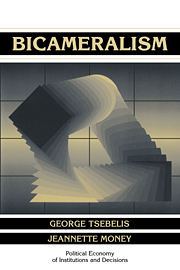Book contents
- Frontmatter
- Contents
- List of tables and figures
- Series editors' preface
- Acknowledgments
- Introduction
- PART I THE HISTORY AND GEOGRAPHY OF BICAMERAL DIVERSITY
- PART II MODELS OF BICAMERAL INSTITUTIONS
- Introduction to Part II
- 3 The core and the uncovered set of bicameral legislatures
- 4 A model of intercameral bargaining
- 5 A model of conference committees and their proposals
- PART III EMPIRICAL STUDIES OF BICAMERALISM AND IMPLICATIONS
- Conclusions
- References
- Index
Introduction to Part II
Published online by Cambridge University Press: 02 December 2009
- Frontmatter
- Contents
- List of tables and figures
- Series editors' preface
- Acknowledgments
- Introduction
- PART I THE HISTORY AND GEOGRAPHY OF BICAMERAL DIVERSITY
- PART II MODELS OF BICAMERAL INSTITUTIONS
- Introduction to Part II
- 3 The core and the uncovered set of bicameral legislatures
- 4 A model of intercameral bargaining
- 5 A model of conference committees and their proposals
- PART III EMPIRICAL STUDIES OF BICAMERALISM AND IMPLICATIONS
- Conclusions
- References
- Index
Summary
What difference does it make if a country has a bicameral legislature instead of a unicameral one? Our purpose in Part II is to outline a framework to answer this question and to analyze the historical and geographic diversity of bicameral institutions. Thus, the overarching research question is supplemented by more detailed investigations of the specific mechanisms of intercameral reconciliation. What difference does it make if the navette system can last for one, or two, or an infinite number of rounds, as exemplified in the procedural rules of Austria, France, and Italy, respectively? What is the effect of a conference committee at the end of the navette instead of a final decision by the upper chamber or the lower one, as exemplified in the procedural rules of Switzerland, the Netherlands, and Spain, respectively? Does it make any difference if the government introduces legislation in the lower house first, as required by many constitutions for budgetary matters? Do conference committees affect the outcomes of bicameral bargaining and, if so, how?
Our account demonstrates that bicameral institutions share features that differentiate their outcomes from unicameral ones. In addition, we show how the institutional variations of bicameralism affect relative house power, providing a series of hypotheses that can be tested systematically. Part II constitutes the theoretical foundation on which we conduct empirical analyses in subsequent chapters, so that, in the conclusions, we will be able to assess critically the arguments on bicameralism proposed by various analysts.
Figure II. 1 presents in a nutshell the problem we investigate in this part of the book. The current policy, the status quo, is indicated in the figure by the point SQ.
Information
- Type
- Chapter
- Information
- Bicameralism , pp. 73 - 79Publisher: Cambridge University PressPrint publication year: 1997
